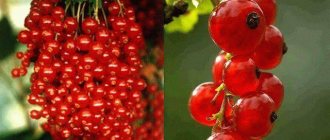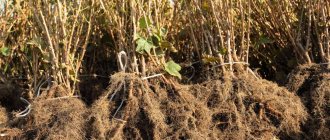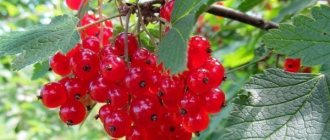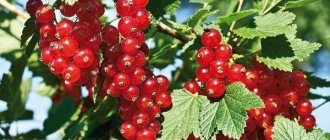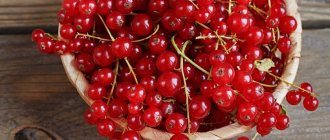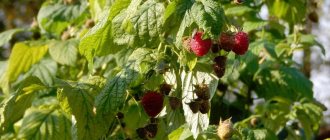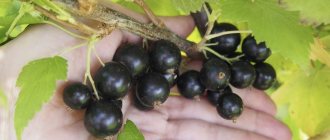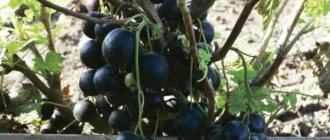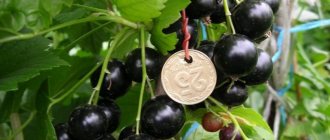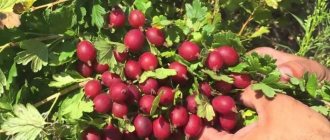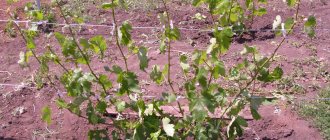Description of the red currant variety Beloved
Currant variety Beloved is characterized as a low-growing, compact bush. It has medium growth vigor. The crown is irregularly rounded. It has slightly spreading branches. During the fruiting period, the branches are dotted with berry clusters. On arched racemes that grow downward, bright red clusters of large berries are densely located. The fruit clusters are very dense, cylindrical in shape and medium in size.
The shrub produces young, large, straight, hairless shoots that look quite thick, hard and even. They form medium-sized buds of an oblong oval shape. The kidneys are slightly deviated. The wood is painted green with a lightened center. The bark of old branches takes on a gray tint. And young shoots are red in color.
The clusters reach a length of about 7 cm, and each cluster contains about 12–14 berries.
The leaves of the bush are not particularly large, reminiscent of maple. The leaf blade is quite rough, not glossy, jagged with blunt edges, divided into 5 lobes. The leaf color is dark green matte. The inflorescences are a very delicate blue shade, with yellow-green sepals. The flowers have reddish streaks. Flowers bloom in early May. The color fades by the end of the month.
Tips and tricks from experienced gardeners
To successfully grow currants of the Beloved variety, you should follow the recommendations of experienced gardeners:
- If the groundwater in the area is higher than 50 cm, then it is better to plant currants on a hill.
- Before planting, dried and damaged roots should be removed.
- Currants do not like chlorine-containing fertilizers.
- For winter protection from rodents, spruce paws are used and a mesh with small cells is installed.
- Red currants do not get along with fruit trees and their black relatives. A suitable neighbor is the gooseberry.
Appearance, characteristics of berries, ripening time, yield
Currant bushes begin to bloom in early May. The variety is distinguished by its self-fertility, which is considered its great advantage. Thus, the plant does not require cross-pollinators and forms ovaries independently. The amount of harvest is absolutely independent of weather conditions and the presence of pollinators in the form of insects.
The fruits themselves begin to ripen at the end of June - in the first half of July . The variety is distinguished by its abundant harvest. On average, more than 3 kg of fruits are obtained from one young bush. Mature bushes can produce up to 12 kg of berries, under conditions of high-quality plant care. Harvesting is recommended at the end of July.
Important! The bush will produce the maximum amount of harvest only after 3
–
5 years of its life, but the plant reaches its peak fruiting in the 9-10th year of growth.
Currant fruits have a bright red color, which is diluted by dark thin stripes. They are characterized by a regular round shape, as well as an ideally equal average size for each berry. The weight of one berry reaches 0.6–0.8 g. The pulp is very tender, juicy and soft, has a sweet taste with pronounced sourness and a light aroma. Pleasant sourness fits very harmoniously into the taste of the berry. The fruits of Beloved are considered one of the sweetest varieties of red currants. Inside the berry there is a small amount of seeds, which are covered with a rather thin skin.
The bunches of berries are very dense and dense and have a very attractive appearance. The berries shine as if covered with varnish. Ripe clusters of shrubs can hang on the branches for quite a long time. Until the fruits are fully ripened and for a long time after this, the clusters remain on the bushes, without falling off and maintaining their taste. The presentable appearance of the berries is also completely preserved; they do not bake in the sun and do not become smaller at the end of the season.
Did you know? Currant berries will serve as an excellent preservative for pickling vegetables. They help improve the taste of vegetables and also increase the benefits of the dish.
The berries have a fairly successful chemical composition. They contain from 6 to 12% sugar, a large amount of organic acids, mineral salts and carotene. The berries also contain tannins and have high levels of vitamin C and pectin.
Main characteristics of culture
In general terms, the description of the Beloved red currant can be characterized as a low-growing, moderately branched bush, densely covered with clusters of berries. For a more detailed description, it is worth studying all the features of the variety:
- The currant bush produces thick young shoots. After lignification, old branches acquire gray bark. Oblong-shaped buds form on the shoots.
- The leaf is large, five-pointed, somewhat similar to the shape of a maple. The surface is rough without gloss.
- The inflorescences are small, saucer-shaped. Yellow flowers with a greenish tint appear in early May, and by the middle of the month they have already faded.
- The berries are collected in clusters. After ripening they acquire a bright red color. The size of all the berries is almost the same. The taste is dominated by sweetness, but there is also a lot of acid. One berry weighs about 0.8 g. The clusters can hang on the branches for a long time. The berries do not fall off spontaneously and retain their taste and beautiful appearance.
Currants are delicious fresh, can be processed, and go well with apples when making jam. The berries contain sugar - up to 12%, acid in the form of vitamin C - up to 30.2 mg/100 g.
Red currant Beloved has gained popularity due to its productivity. The average is 9 kg per bush. In the first year, a young plant produces up to 3 kg of berries. The yield of an adult bush with good feeding and weather conditions reaches 12 kg. The ripening of berries begins in late June. In a prolonged spring, the dates shift to the beginning of July.
The variety is considered 60% self-fertile. Even with poor bee coverage, self-pollination will occur, which guarantees an annual harvest. Beloved currant bushes tolerate cold winters well. The variety is adapted to the weather conditions of the middle zone. Wintering occurs without necessarily covering the bushes.
The video talks about the Beloved variety:
Advantages and disadvantages of the variety
Reviews from gardeners sound both positive and negative, therefore, in order to grow a crop and get the maximum benefit from it, it is important to know all the detailed characteristics of the variety.
- Advantages of the variety:
- high productivity, abundant harvest;
- high winter hardiness, the plant does not need special care and shelter in winter and is able to survive harsh winters without being damaged;
- ease of care;
- excellent self-fertility, does not require additional pollinators;
- resistance to powdery mildew, fungal diseases, as well as various types of pests;
- durability;
- pleasant taste of berries due to the presence of high sugar levels;
- decorative qualities of the plant;
- diversity of shrub formation;
- versatility of berries;
- possibility of long-term fresh storage of fruits;
- preservation of presentation during transportation;
- the berry is rich in mineral salts and organic acids, as well as tannins, pectin substances and vitamins: carotene, vitamin C;
- the berries can be eaten fresh as a dessert and are also suitable for processing;
- helps with colds and is also good for health.
- Disadvantages of the variety:
- vulnerable to white spotting;
- susceptible to the development of glass rust;
- not resistant to drought and hot weather conditions;
- during flowering it is not resistant to repeated frosts;
- does not bear fruit well in the shade.
Agricultural technology
To obtain maximum benefit and yield from the crop, it is important to follow the rules of planting and further care of the plant.
Choosing a place and landing
Slightly acidic loamy soils are considered the most suitable place for planting red currants of the Beloved variety. The soil should be light, slightly moist, well-drained, and also rich in minerals. Groundwater should lie deep, otherwise it is better to plant the plant on hills. In low areas, the crop produces a modest harvest and the berries become smaller.
If planting needs to be done in heavy clay areas with high acidity, the soil should be stabilized in advance with peat or sand.
The place should be open to sunlight and well lit. Light is an important component of the quality of a plant's harvest.
Any crops can be suitable as neighbors. However, it is best to plant the plant near gooseberry varieties that have a beneficial effect on the growth of the bush and fruit. However, it is not recommended to place the Beloved variety near black currant varieties. The optimal time for planting a plant is considered to be early autumn.
Important! Currants are considered long-lived, so they require an ideal place for planting. The life span of the bush is more than 25 years.
When purchasing a seedling, it is necessary to check the condition of the root system, which should be especially developed. The plant should have at least 1-2 main roots, as well as a large number of adventitious ones. The roots should be sufficiently moist, without damage or breaks. To ensure the health of the shoots, you can make a small cut. The inside color should be green.
Currant planting scheme:
- First you need to prepare the soil, dig it up and apply fertilizers in the form of organic matter and minerals.
- Dig a hole at least 60 cm deep. The ideal hole size is 50x50 cm. The holes should be located at a distance of more than 2 m. In the future, the bushes will need enough space for further development.
- 2 hours before planting, it is necessary to prepare a red currant seedling for planting. To do this, you need to tear off the dry roots, shorten the stems, leaving about 6 buds, and place the plant in water.
- Next, the plant should grow new roots. For a faster effect, it is recommended to add Kornevin solution to the water.
- Wood chips or finely chopped branches should be poured into a thick layer at the bottom of the prepared hole.
- Next, you need to spread the fertilizer with fertile soil, pour dolomite, chalk, compost or river sand on top.
- To compact all layers, you need to fill the hole with water.
- After this, a mound of earth is formed at the bottom of the hole.
- Before planting the plant, be sure to straighten the roots.
- Bury the seedling into the ground by 3 buds.
- Plant the plant with the stem slightly tilted to the side.
- Cover the seedling with soil. If the soil is too hard, it is recommended to add a little sand.
- Water the bush generously. If the roots are on the surface, sprinkle them with soil.
- There is no need to compact the soil.
Landing Features
Planting any plants has its own characteristics that must be taken into account. Red currants should not be placed under fruit trees; they do not tolerate shade or waterlogged soil.
Optimal timing
It is best to plant red currants in the fall, in early September. Before the cold weather, the bush will have time to take root; in the spring it will be a strong seedling with strong immunity. If the seedling was purchased in the spring and already has green leaves, it can also be planted, but the plant will require a little more care. You should not pick off the leaves of the seedling; only remove the buds.
Before planting, the plant is immersed with its roots in water with the addition of Zircon or Epin. The plant will be saturated with moisture and beneficial substances contained in the root formation stimulator. After planting, such a weak seedling needs moisture and light shade until it gets stronger.
Seedlings purchased in pots in the summer are replanted immediately, they are watered in advance and carefully removed from the container along with the earthen lump. Autumn planting is optimal for red currants; the main thing is to plant the bush in time.
Important: if it is placed in open ground in October-November, the seedling will not have time to take root and grow stronger, so it will certainly die with the onset of cold weather.
The main advantage of such planting is that the seedlings on sale are fresh, they have not been stored for several months in unknown conditions, they are strong and strong.
Selection and preparation of a site
The beloved one needs a sunny area with good soil drainage; you can choose a hillock or a well-lit slope. The selected area is cleared of weeds and dug deep.
Red currants should not be planted next to black ones - both will suffer from such proximity. Do not place it next to other berry bushes: raspberries, cherries. The combination of currants with onions and garlic would be optimal. Vegetables will provide her with additional protection from pests and diseases.
How to choose a healthy and strong seedling
It is best to purchase planting material from specialized nurseries. There you can read the documents; sellers are responsible for their products. They buy two-year-old and one-year-old seedlings; two-year-olds are stronger and more expensive.
Before purchasing, carefully examine the roots of the plant. They should be well developed, without signs of rot. Skeletal roots (at least 3 of them) are elastic, moistened, with traces of clay mash. The branches are strong and elastic.
Landing technology
Red currants love space; when preparing holes for seedlings, the distance between them is 1.5 meters. If you plan to plant several rows, provide a 2-meter distance between them.
Tip: pits should be prepared 10-14 days before planting so that the soil has time to settle.
The finished pit should be 50 centimeters in diameter and depth. It is filled by a third with organic matter mixed with soil, compost, and mullein, which is poured into a heap. Complex mineral fertilizer is added. The seedling is placed in the hole at an angle. This ensures the development of the root system and shoots. The roots are carefully straightened, the hole is filled with soil and compacted. The planting needs to be watered at the rate of 4-5 liters per bush. The soil under the bush is mulched.
Care
Care is very important for any plant, as it affects the volume of the harvest and the taste of the berries themselves. The main components of plant care are watering, loosening, weeding, removing weeds and fertilizing. However, currants do not require regular and mandatory care and can easily do without it.
Important! Currants react negatively to chlorine, so fertilizers that contain it should not be used in places where they are planted. The soil is not limed.
Immediately after planting, the plant is watered with plenty of water, so in most cases there is enough moisture until spring. Thus, currants of the Beloved variety do not require regular watering in the days following planting. However, it is very important to water the plant in a timely manner during the fruiting period, since the time falls during hot and dry weather.
Even at the end of May, when the ovaries appear, you need to ensure that the soil is moistened at least 40 cm in depth. During fruit bearing and until the end of their ripening, the bush should receive no less than 5 buckets of water per bush.
In the process you need to dig a small hole. The entire amount of water should not be poured out at once. First, you need to pour out only one bucket, thereby simply moistening the soil under the plant. After the water has completely absorbed, you can pour out all the remaining water. It is better to water the plant in the evening to prevent rotting of the roots due to the possibility of them steaming in the soil hot from the sun.
Find out how to feed currants with starch.
The currant variety Beloved generally does not require mandatory feeding and will grow well without it. But to obtain better quality berries and for more active development of the bush, you can periodically apply fertilizer to the plant. After planting, currants actively use fertilizers applied in advance for 2-3 years. After this, nutrients are advised to be replenished. In the future, you need to fertilize the soil at intervals of 3-4 years.
Before applying fertilizing, you need to dig small holes around each bush. Urea, humus or peat can be used as fertilizers. Such substances will benefit the plant in March-April, after frost. When the bush is flowering, you can use mullein solution. And to obtain more yield, currants are treated with a solution of boric acid. As a result, the fruits will set larger. This treatment is usually performed in the evening and in dry weather.
Humus, peat, compost or phosphorus-potassium fertilizers are used as mulch to replenish useful microelements. The thickness of the mulch layer reaches up to 10 cm.
Video: how to mulch the soil correctly
Reproduction methods
To obtain red currant seedlings of the Beloved variety, you need to select high-yielding healthy bushes. There are several methods of reproduction:
- cuttings - lignified, semi-lignified (leafy), green and combined;
- layering;
- dividing the bush.
The most common of them is lignified cuttings. They are harvested at the end of August or at the beginning of September: leaves are removed from 2-3-year-old strong branches and cut into pieces 18-20 cm long. The cut from below should be oblique, at an angle of 45˚ 1 cm below the bud, at the top the cut is made at at a right angle 1 cm above the kidney. The soil is prepared a month before planting - fertilizer is applied and dug with a shovel, and plant debris is removed. For 1 m2 add to the soil:
- 6-10 kg of manure;
- 50-70 g superphosphate;
- 20-30 g potassium sulfate;
- 10-12 kg of lowland peat.
The cuttings are planted at an angle of 45˚ according to the 10x20 pattern. Before planting, they should be kept in a Heteroauxin solution for 24 hours or dusted with Kornevin. The soil is watered abundantly and mulched. After a month and a half, the seedlings will take root and are transferred to a permanent place.
Plum variety Renklod Soviet: description and characteristics of the variety, photo
Rooting of semi-lignified cuttings occurs in a greenhouse with high air humidity. The work is carried out in early August. The leaves are not sniffled. After 2.5 months, the cuttings reach the size of annual seedlings.
In spring, Beloved currants are propagated by horizontal layering. To do this, choose strong 1-year-old branches, shorten them, pin them and dig in them. Growing shoots are hilled up to half their height 2-3 times per season. At the end of September or in spring, the branches are cut off from the mother bush and divided into separate bushes.
Dividing the bush is used quite rarely. In the fall, the bush is completely dug up, the old branches are cut out, the young ones are shortened to 20-30 cm. The bush is divided into parts so that each of them has well-developed buds at the base and a branched root system.
Disease and pest control
Pests and diseases of the Beloved red currant variety can cause significant damage to the crop and can destroy entire plantations of shrubs. It is necessary to distinguish them by their main symptoms and signs, as well as know methods of treating diseases and methods of pest control.
Find out how to deal with lichen and moss on currants.
In general, this species is resistant to dangerous diseases and a number of pests. Beloved is very resistant to powdery mildew infection and tick attacks. Also, the variety usually does not damage the fungus. However, there are several types of diseases that can harm the crop:
- Glass rust. A fungal disease that develops during wet and humid spring. Signs of the disease are the formation of large fungal spores on the inside of the leaf blade, shoots and green ovaries, which in appearance resemble yellow pads. The damaged parts are deformed, use the shape of glasses, dry out and soon crumble. To combat the infection, it is necessary to use Bordeaux mixture. Shrubs must be treated three times. The plant is sprayed for the first time during the period of leaf blossoming, the second time at the beginning of the appearance of color, and the third time after flowering ends.
- Septoriz. The disease manifests itself in the form of small round spots with a brownish tint. Over time, they acquire a white tint and black dots inside. Soon the leaves dry out and begin to fall off. To protect the plant, it is necessary to treat the bushes with a solution of Bordeaux mixture. You can also use the drugs “Circom” or “Fitosporin”. This should be done before flowering and after harvesting.
It is very important to begin treating currant diseases immediately after detecting its first signs. At the first symptoms, you can get by by treating the plant with iodine solution or Fitosporin. At a more complex stage, in addition to Bordeaux mixture, copper sulfate or copper oxychloride is also used.
Find out how to use Fitosporin-M on currants.
Diseases such as mosaic, terry and other viral diseases cannot be treated. Therefore, the bushes are simply destroyed and the soil is left empty for the next 5 years.
Currants of this variety are often attacked by insects such as:
- leaf gall midge;
- currant borer;
- spider mite;
- glassware;
- moth;
- aphid;
- bud moth.
Fitoverm or Agravertin are used for pest control. To resist the attack of aphids, the plant is treated with a soda solution. To prevent diseases and pests, the drug “Zircon” is used, which must be used to treat the shrub in the spring and autumn.
Pruning and shaping the bush
During the first year after planting, currants of the Beloved variety do not require pruning or bush formation. During the initial 2-3 years of life, the plant builds up its root system, and only then does its above-ground part begin to grow. That is why pruning a bush consists only of destroying diseased or damaged shoots.
Did you know? A healing juice is obtained from red currant berries, which has a cleansing effect, improves intestinal function, and also helps remove uric acid salts. The juice is also considered a diaphoretic that helps with colds.
Pruning must be done in spring. This must be done before the bush begins to secrete juice. Otherwise, the plant will be exhausted, immunity will be significantly reduced, which will negatively affect fruiting.
Fig.1. Currant pruning: a - one-year-old seedling; b - two-year-old bush; c, d - shortening of shoots. Fig.2. Currant bush before anti-aging pruning (a), after it (b) and pruning of a neglected bush (c).
After the first year of life, the branches of the bush must be cut by a quarter. In the second year, all weak branches of the bush are cut off, leaving 3-4 of the most powerful shoots. Remove branches at the root, leaving no stumps. Further pruning must be done annually. They leave 2-3 branches of different ages on the bush. It is impossible to trim the ends of the branches of the bush, since they contain fruit branches, which will later bear the largest amount of harvest.
History of crop selection and region of growth
The Beloved variety was bred in the late 80s of the last century at the Belarusian Research Institute of Fruit Growing. Breeder A.G. Voluznev, by crossing three varieties - Wonderful, Dutch Red and Cherry, managed to obtain an excellent high-yielding new product. The abundance of red berries on a bright green background of foliage made the currant bushes so attractive that the variety was named Beloved and in 1991 was included in the Belarusian State Register of Varieties; in 2006, Beloved was allowed to be grown in Russia.
Harvesting and transportation, keeping quality of berries
The day for harvesting must be chosen as sunny, the weather must be dry and warm. The fruits are collected with brushes. The dry method is used for cleaning, so it can be either manual or mechanical cleaning.
The berries are characterized by high transportability. They are also able to hang on a bush for a long time without deteriorating or falling off. For storage, the crop must be harvested when ripe. To do this, you need to sort through the fruits, selecting damaged berries, put the product in plastic bags, packing 1–1.5 kg of berries in each.
The bags are then sealed and placed in the refrigerator. In this way, the crop is stored for up to 3 months. For longer storage, berries should be frozen.
The Beloved red currant variety is considered a very successful berry plant for planting in gardens and summer cottages. The culture is very fertile, and the berries are considered very healthy and rich in vitamins. Several currant bushes provide a sufficient harvest for the whole year. The berries are universal for processing and are used to make jam, jam, jelly, and marmalade. The berries are used to make compotes and fruit drinks, as well as make juice and wine. Beloved is suitable for filling and decorating desserts, and is also considered an excellent fresh delicacy.
How to propagate currants
Plantings are propagated by dividing the bush, cuttings or layering.
Dividing the bush
This method is suitable if the bush needs to be moved to another place. In this case, it should be dug up and divided into several parts, leaving young shoots and healthy roots on each. The bush is divided into 2-3 parts.
Cuttings
Small cuttings, 15-20 centimeters high, are cut from healthy, strong and mature branches and placed at an angle in open ground. The cutting must have 4 buds. The cuttings are watered, weeded and by autumn a grown plant is obtained for planting in a permanent place.
By layering
A young branch is pressed to the ground, secured with wire or staples, preventing it from straightening, and sprinkled with soil. By autumn, several independent plants with roots and shoots will develop from the buds on the branch. They are separated with a knife or shovel and seated.
